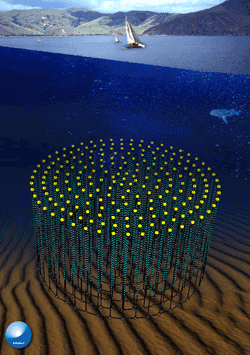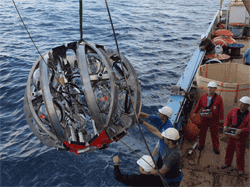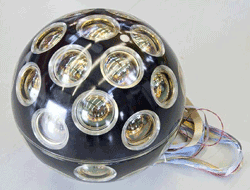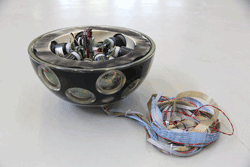Fundamentals: Detecting neutrinos via KM3NeT
Hopes are high that the second-largest manmade structure ever built will allow researchers to study the astrophysical neutrino
Plans are in the works to build the second-largest manmade structure ever in order to study astrophysical neutrinos and other subatomic particles. It’s called “KM3NeT” and will consist of an array of super-sensitive detectors anchored 3,200 feet below the Mediterranean Sea.

Artist simulation of KM3NeT footprint. (Via: Propriety KM3NeT Consortium)
Funds are still being secured for this project, so plans are still in the development stages. In the meantime, here are some things to know that’ll help you follow the story.
Astrophysical neutrino background
Neutrinos are particles formed in different types of radioactive decay, including in the sun, nuclear reactors, and cosmic ray collisions. As the name suggests, they are neutral. This means they can move through matter practically unimpeded. It also means they lack charge, so they’re immune to inhibitors like electromagnetic forces.
The goal of KM3NeT is to detect a specific, rather elusive group of neutrinos known as astrophysical neutrinos. They originate in deep space and are generated from some of the Universe’s most powerful places, including gamma ray bursts, black holes, and cosmic collisions.
Since they lack charge, they can travel through space unimpeded by magnetic forces from the sun or planets. Researchers are hoping that in capturing them once they’ve entered our planet, they will help answer several questions we have about the cosmos; questions like the origin of the cosmic ray (a proton flux that rains down on Earth.) Right now, these rays come from an unknown source because they don’t point back to their original sources (unlike neutrinos, protons are subject to a variety of inhibitors.) Observing the interactions of the astrophysical neutrinos that come with these rays can help researchers reconstruct their path.
How do you study the astrophysical neutrino when it doesn’t interact with anything?
In a summary probably too short to do the research any justice, it was discovered after years of studying the neutrino that it is, in fact, possible to force the particle to interact with matter, albeit very weakly. All you have to do is place the neutrino in a detector with a pressure of, approximately speaking, 2.2 billion lbs.
This brings us to why the KM3NeT is being submerged so deep underwater. In addition to providing the pressure necessary to observe an astrophysical neutrino reaction, the thousands of feet of surrounding water will act as a particle filter, minimizing the chance of stray particle detection.
More specifically, the Mediterranean Sea has the right depth and provides water of excellent optical properties. It also has an ideal shore-based infrastructure for on-shore data processing (as opposed to, say, gathering data out in the middle of the ocean.)

Researchers prototyping a deployment method of KM3NeT detection unit. (Via: Propriety KM3NeT Consortium)
Project concept
The basis of thought for the KM3NeT is this: When the astrophysical neutrino travels through the water and enters the KM3NeT’s space, due to the speed at which it is traveling, coupled with the significant pressure it will be under, it will provoke an ever-so-slight response in a charged water particle, breaking through the nucleus of its atom to produce an outgoing particle called a muon. When the muon is released, it radiates a cone of light.
To capture this momentary interaction, commonly referred to as “Cherenkov radiation,” KM3NeT will be made up of a cubed array of optical modules that point towards the sea floor (this limits the chance that the detectors might pick up stray atmospheric neutrinos.) Each module has an angular resolution for muon events greater than 0.1 degree, for neutrino energies that exceed 10 TeV and have an energy threshold of 100 GeV. Layman’s translation: nothing’s getting past it.
Some basic background on the KM3NeT
In case you’ve been wondering, the oddly titled KM3NeT is actually an acronym. It stands for “Cubic Kilometer Neutrino Telescope” because the project will cover more than three cubic kilometers of prime Mediterranean Sea floor real estate. Presently, there are 40 institutes and universities from ten European countries involved in this project.
And while the infrastructure’s primary purpose will be to house an underwater neutrino observatory, it will also be home to an oceanography observatory.
The numbers
The aforementioned optical modules are designed to withstand six atmospheres of pressure or, approximately speaking, the pressure of being 20,000 feet below sea level. Each one is a 17-inch sphere that holds 31 3-inch photomultiplier tubes, and is surrounded by a light concentrator ring to increase the total light collection area. They also include calibration sensors like acoustic piezo sensors, compass and tilt meters, and nanobeacons, for additional research.

KM3NeT optical module closed. (Via: Propriety KM3NeT Consortium)

KM3NeT optical module open. (Via: Propriety KM3NeT Consortium)
Modules will be mounted onto 20-foot-long bars, and 40 bars will be connected to each unit. There’ll be about 100 of these unit towers per cubic kilometer of water, and the whole network will be connected by way of a series of stainless steel tubes that contain within them optical fibers linked to shore-based data stations.
The towers are presently being designed to stand taller than the 2,723-foot Burj Khalifa tower in Dubai (the tallest building in the world). When all’s said and done, KM3NeT will be the second-largest manmade structure ever, behind only the Great Wall of China. Unfortunately, it will never be seen due to its unique underwater positioning.

Height of unfurled KM3NeT detection unit. (Via: Propriety KM3NeT Consortium)
Not the first go-round
KM3NeT is the latest attempt in a long line of super-big, super-sensitive detectors. The one closest in comparison to it is the IceCube Neutrino Observatory, a neutrino telescope constructed at the Amundsen-Scott South Pole Station in Antarctica. Completed less than a year ago, its first-year data won’t be available for the next few months.
The IceCube is similar to KM3NeT in that it uses the Earth as a filter to block out background radiation and find neutrinos. It also uses a deep, dense medium to hunt for Cherenkov light. But that’s where the similarities end. You see, the IceCube’s a lot smaller: just one cubic kilometer to the KM3NeT’s three. Also, the IceCube looks to the northern sky, while KM3NeT is pointed south, incidentally in the direction of the galactic center as seen from Earth (more on that below).
The IceCube is currently the largest detector in the world, but researches realized that when you are looking for something with as little flux as an astrophysical neutrino, you need as much volume as possible. That’s why the KM3NeT is going to be so much bigger. And thanks to the continued advancements made in technology, it will also be much more sensitive than the IceCube.
Once KM3NeT has completed construction, these two massive detectors can actually work together. They will allow researchers to fully view the sky and form a global neutrino observatory.
KM3NeT is also being built on the experience of three pilot projects in the Mediterranean Sea: the ANTARES detector, the NEMO experiment, and the NESTOR Project. ANTARES is, for now at least, the largest neutrino observatory in the northern hemisphere, but with KM3NeT getting underway, this is likely to change in the near future.
The galactic center
The fact that KM3NeT is pointed in the direction of the Galactic Center is worth noting because this is where researchers believe a supermassive black hole exists. If true, it could help researchers with the identification of dark matter. All they need to find are neutrinos produced by neutralino annihilation; that is, hypothetical particles believed to accumulate in the centers of very large objects in space.
No big deal, right?
Outlook
Building KM3NeT is still a matter of securing funds and dealing with European geopolitics. The Italian section was recently funded though, so it’s looking like preliminary construction will begin next year.
Want to learn more?
In 2010, a design study of the infrastructure was concluded with a Technical Design Report. It was made public this past year: km3net.org/TDR/TDRKM3NeT.pdf ■
Reference for this article via:
1. popsci.com/technology/article/2011-11/new-neutrino-net
2. km3net.org
Pictures for this article via:
1. km3net.org
Advertisement
Learn more about Electronic Products Magazine





